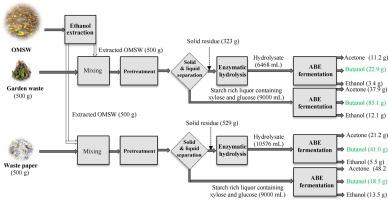Waste Management ( IF 7.1 ) Pub Date : 2020-09-02 , DOI: 10.1016/j.wasman.2020.07.053 Sara Farmanbordar 1 , Hamid Amiri 2 , Keikhosro Karimi 3

|
Co-processing of lignocellulosic wastes, e.g., garden and paper wastes, and the organic matters fraction of municipal solid waste (OMSW) in an integrated bioprocess is a possible approach to realize the potential of wastes for biobutanol production. Dilute acid pretreatment is a multi-functional stage for breaking the recalcitrant lignocellulose’s structure, hydrolyzing hemicellulose, and hydrolyzing/solubilizing starch, leading to a pretreated solid and a rich hydrolysate. In this study, dilute-acid pretreatment of the combination of wastepaper and OMSW, composite I, as well as garden waste and OMSW, composite II, at severe conditions resulted in “pretreatment hydrolysates” containing 33.7 and 19.4 g/L sugar along with 18.9 and 33.2 g/L soluble starch, respectively. In addition, the hydrolysis of solid remained after the pretreatment of composite I and II resulted in “enzymatic hydrolysates” comprising 19.4 and 33 g/L sugar, respectively. The fermentation of the pretreatment hydrolysates and enzymatic hydrolysates resulted in 3.5 and 6.4 g/L ABE from composite I and 15 and 5.2 g/L ABE from composite II, respectively. In this process, 148 and 173 g ABE (60 and 100 g gasoline equivalent/kg) was obtained from each kg composite I and composite II, respectively, where co-processing of OMSW with lignocellulosic wastes resulted in 10 and 49% higher ABE than that produced from the individual substrates.
中文翻译:

城市固体废物与木质纤维素废物协同处理的协同作用,以改善生物丁醇的生产。
在集成的生物过程中对木质纤维素废料(例如花园废料和纸屑废料)和城市固体废物(OMSW)的有机物部分进行共处理,是实现废物在生物丁醇生产中的潜力的一种可能方法。稀酸预处理是一个多功能阶段,用于破坏顽固性木质纤维素的结构,水解半纤维素和水解/增溶淀粉,从而得到预处理的固体和丰富的水解产物。在这项研究中,废纸和OMSW(复合材料I)以及花园垃圾和OMSW(复合材料II)的组合在苛刻的条件下进行了稀酸预处理,得到了“预处理水解物”,其中含有33.7和19.4 g / L的糖以及18.9的糖。和33.2 g / L的可溶性淀粉。此外,在复合物I和II进行预处理后,残留的固体水解产生分别包含19.4和33 g / L糖的“酶水解物”。预处理水解产物和酶水解产物的发酵分别从复合物I产生3.5和6.4 g / L ABE,从复合物II得到15和5.2 g / L ABE。在此过程中,分别从每公斤复合材料I和复合材料II中获得148和173 g ABE(每公斤60和100 g汽油当量),其中OMSW与木质纤维素废料的共处理导致的ABE比分别高出10%和49%由各个底物产生的。分别来自复合物I的4 g / L ABE和来自复合物II的15 g和5.2 g / L ABE。在此过程中,分别从每公斤复合材料I和复合材料II中获得148和173 g ABE(每公斤60和100 g汽油当量),其中OMSW与木质纤维素废料的共处理导致的ABE比分别高出10%和49%由各个底物产生的。分别来自复合物I的4 g / L ABE和来自复合物II的15 g和5.2 g / L ABE。在此过程中,分别从每公斤复合材料I和复合材料II中获得148和173 g ABE(每公斤60和100 g汽油当量),其中OMSW与木质纤维素废料的共处理导致的ABE比分别高出10%和49%由各个底物产生的。









































 京公网安备 11010802027423号
京公网安备 11010802027423号